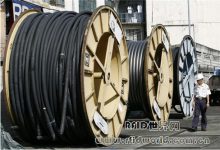
Canadian utility company uses RFID system to track cable reels for real-time visibility
[ad_1]
A Canadian utility company that declined to be named is now using an RFID system to track 3000-4000 cable reels (before they are sent to construction sites) circulating in distribution centers and 9 storage yards. The RFID system MOBILEFusion is provided by AppLocation Systems of Canada.
The MOBILEFusion system began its trial in January this year. AppLocation creator Gary Hartwig said that the Canadian utility company officially launched the system in its distribution center and nine storage yards in March.
The Canadian company sought an application solution from AppLocation in November 2007, with the purpose of tracking the cable reels from the distribution center to the construction site. There are many sizes of reels, ranging in height from 36 inches to 5 feet. The reels are wound with cables required for various construction projects. When the cable was used up, the empty reel was sent back to the company for reuse.
Cable reels are usually stored in third-party distribution centers until they are shipped to a storage yard close to the construction site. Because multiple parties participate in the purchase and transportation of cables, it is difficult for traditional paper records and telephone tracking to achieve accurate inventory counts. For example, a sales company representing a contractor often calls to place orders and sends trucks to pick up cables, while the company itself sends trucks or hires a transportation team to pick up cables to fulfill other orders.
Since it is possible that both parties take the same cable reel, this leads to a shortage of cables. This not only affected the company (lost business), but also affected transportation companies, sales staff and contractors, all of whom were delayed in their work. Therefore, the company prefers to stock too much in the distribution center to avoid shortages.
The company hopes to achieve precise tracking of reels in distribution centers and open storage yards. In the future, the company plans to use on-board GPS technology to track cables that are transported to construction sites.
According to Hartwig, the company now installs a rugged, active 915 MHz label with a size of 3 inches by 1 inch on wooden or metal reels that are shipped to RFID distribution centers and storage yards, with a bar code printed on the front of the label.

Use RFID tags to track cables in distribution centers and storage yards
After the label is installed, the employees of the company use Motorola’s barcode scanner to scan the barcode, and then manually enter the size, type and RFID number of the cable on the reel in the back-end system. If the roll is reused, then just scan the label and enter the new position data. This information is also uploaded to a web-based server. The authorized party can enter the password to log in to the website to view relevant information. The website includes a logo map, and the authorized party can choose the logo to track a specific product.
When the roll is finished labeling, it is shipped to the distribution center. When the reel enters and leaves the distribution center, a RFind fixed RFID reader in the center obtains the ID code of the tag. Similarly, when tags enter or leave the storage yard, the tags will also be read. A maximum of 5 readers are installed in each venue. The reading distance of each reader is 700 meters, ensuring real-time information transmission at any point on the field. In this way, companies and authorized parties can track whether a certain roll has left the distribution center or find its real-time location in the stockyard.
In addition, the tag is also equipped with a motion sensor. If the roll is removed without authorization, the sensor will send an alert to the reader, and the site administrator will receive an email alert immediately.
In the future, the company also plans to expand the application of GPS systems and install GPS devices on trucks that transport cables. When the trucks go from the distribution center to the storage yard, from the storage yard to the construction site, the GPS device of each truck will send its position signal at a certain interval.
The company plans to fully adopt this system in 9 storage yards in mid-October, and in 2009, began to install this system in all 50 storage yards. The company claims that this RFID system is expected to increase operational efficiency by 10%-15%.
[ad_2]



